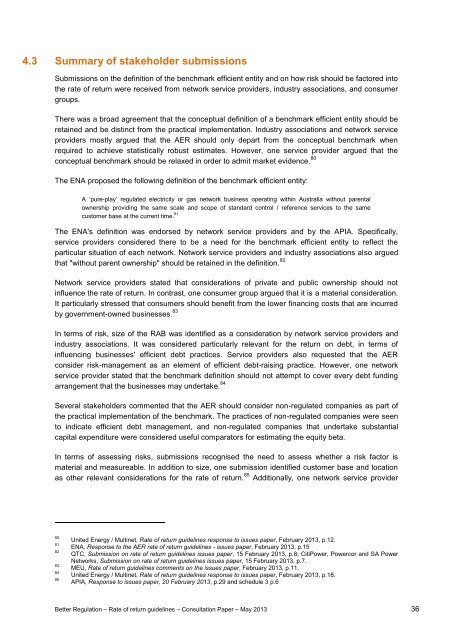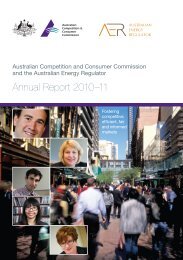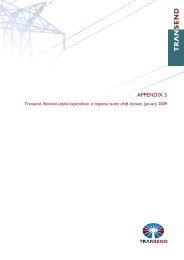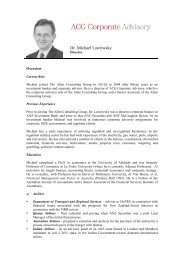Consultation paper Rate of return guidelines - Australian Energy ...
Consultation paper Rate of return guidelines - Australian Energy ...
Consultation paper Rate of return guidelines - Australian Energy ...
Create successful ePaper yourself
Turn your PDF publications into a flip-book with our unique Google optimized e-Paper software.
4.3 Summary <strong>of</strong> stakeholder submissions<br />
Submissions on the definition <strong>of</strong> the benchmark efficient entity and on how risk should be factored into<br />
the rate <strong>of</strong> <strong>return</strong> were received from network service providers, industry associations, and consumer<br />
groups.<br />
There was a broad agreement that the conceptual definition <strong>of</strong> a benchmark efficient entity should be<br />
retained and be distinct from the practical implementation. Industry associations and network service<br />
providers mostly argued that the AER should only depart from the conceptual benchmark when<br />
required to achieve statistically robust estimates. However, one service provider argued that the<br />
conceptual benchmark should be relaxed in order to admit market evidence. 80<br />
The ENA proposed the following definition <strong>of</strong> the benchmark efficient entity:<br />
A ‘pure-play’ regulated electricity or gas network business operating within Australia without parental<br />
ownership providing the same scale and scope <strong>of</strong> standard control / reference services to the same<br />
customer base at the current time. 81<br />
The ENA's definition was endorsed by network service providers and by the APIA. Specifically,<br />
service providers considered there to be a need for the benchmark efficient entity to reflect the<br />
particular situation <strong>of</strong> each network. Network service providers and industry associations also argued<br />
that "without parent ownership" should be retained in the definition. 82<br />
Network service providers stated that considerations <strong>of</strong> private and public ownership should not<br />
influence the rate <strong>of</strong> <strong>return</strong>. In contrast, one consumer group argued that it is a material consideration.<br />
It particularly stressed that consumers should benefit from the lower financing costs that are incurred<br />
by government-owned businesses. 83<br />
In terms <strong>of</strong> risk, size <strong>of</strong> the RAB was identified as a consideration by network service providers and<br />
industry associations. It was considered particularly relevant for the <strong>return</strong> on debt, in terms <strong>of</strong><br />
influencing businesses' efficient debt practices. Service providers also requested that the AER<br />
consider risk-management as an element <strong>of</strong> efficient debt-raising practice. However, one network<br />
service provider stated that the benchmark definition should not attempt to cover every debt funding<br />
arrangement that the businesses may undertake. 84<br />
Several stakeholders commented that the AER should consider non-regulated companies as part <strong>of</strong><br />
the practical implementation <strong>of</strong> the benchmark. The practices <strong>of</strong> non-regulated companies were seen<br />
to indicate efficient debt management, and non-regulated companies that undertake substantial<br />
capital expenditure were considered useful comparators for estimating the equity beta.<br />
In terms <strong>of</strong> assessing risks, submissions recognised the need to assess whether a risk factor is<br />
material and measureable. In addition to size, one submission identified customer base and location<br />
as other relevant considerations for the rate <strong>of</strong> <strong>return</strong>. 85 Additionally, one network service provider<br />
80<br />
81<br />
82<br />
83<br />
84<br />
85<br />
United <strong>Energy</strong> / Multinet, <strong>Rate</strong> <strong>of</strong> <strong>return</strong> <strong>guidelines</strong> response to issues <strong>paper</strong>, February 2013, p.12.<br />
ENA, Response to the AER rate <strong>of</strong> <strong>return</strong> <strong>guidelines</strong> - issues <strong>paper</strong>, February 2013, p.15<br />
QTC, Submission on rate <strong>of</strong> <strong>return</strong> <strong>guidelines</strong> issues <strong>paper</strong>, 15 February 2013, p.8; CitiPower, Powercor and SA Power<br />
Networks, Submission on rate <strong>of</strong> <strong>return</strong> <strong>guidelines</strong> issues <strong>paper</strong>, 15 February 2013, p.7.<br />
MEU, <strong>Rate</strong> <strong>of</strong> <strong>return</strong> <strong>guidelines</strong> comments on the issues <strong>paper</strong>, February 2013, p.11.<br />
United <strong>Energy</strong> / Multinet, <strong>Rate</strong> <strong>of</strong> <strong>return</strong> <strong>guidelines</strong> response to issues <strong>paper</strong>, February 2013, p.18.<br />
APIA, Response to issues <strong>paper</strong>, 20 February 2013, p.29 and schedule 3 p.6<br />
Better Regulation – <strong>Rate</strong> <strong>of</strong> <strong>return</strong> <strong>guidelines</strong> – <strong>Consultation</strong> Paper – May 2013 36







